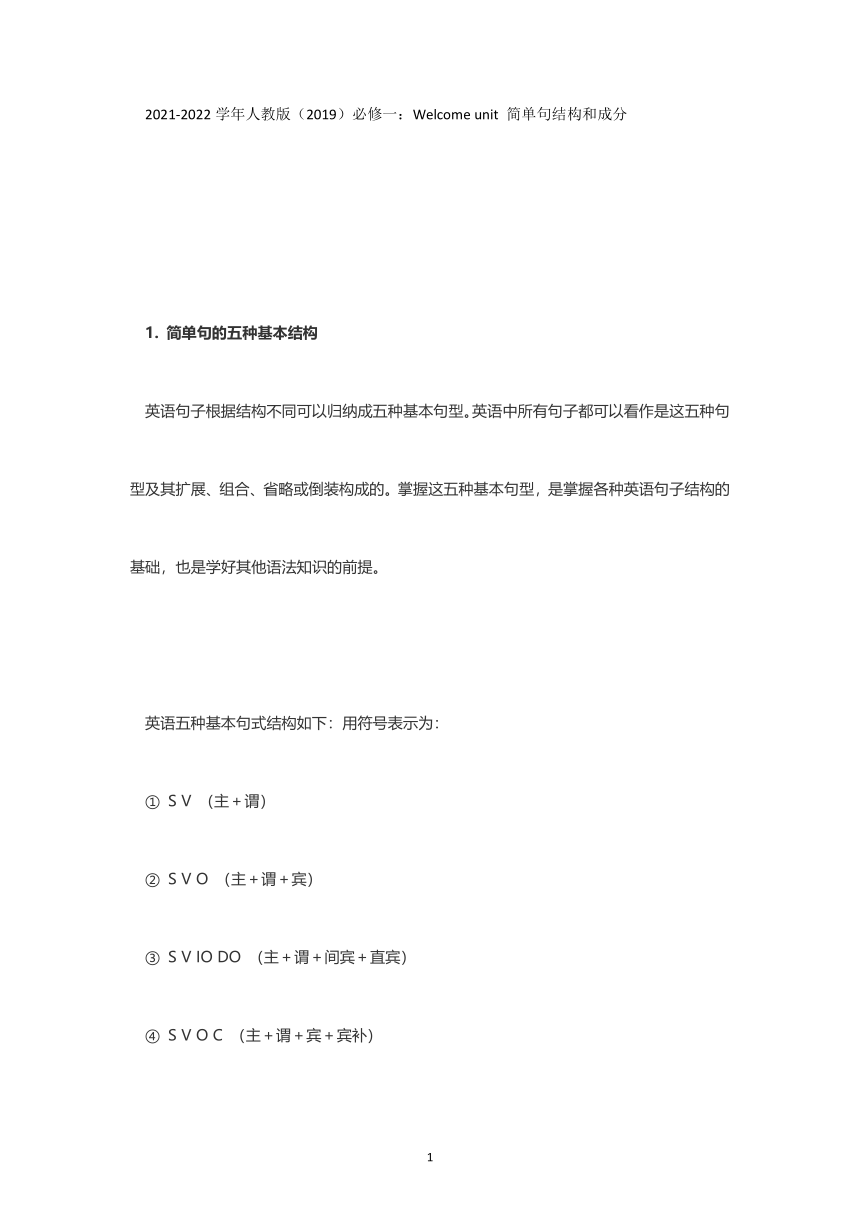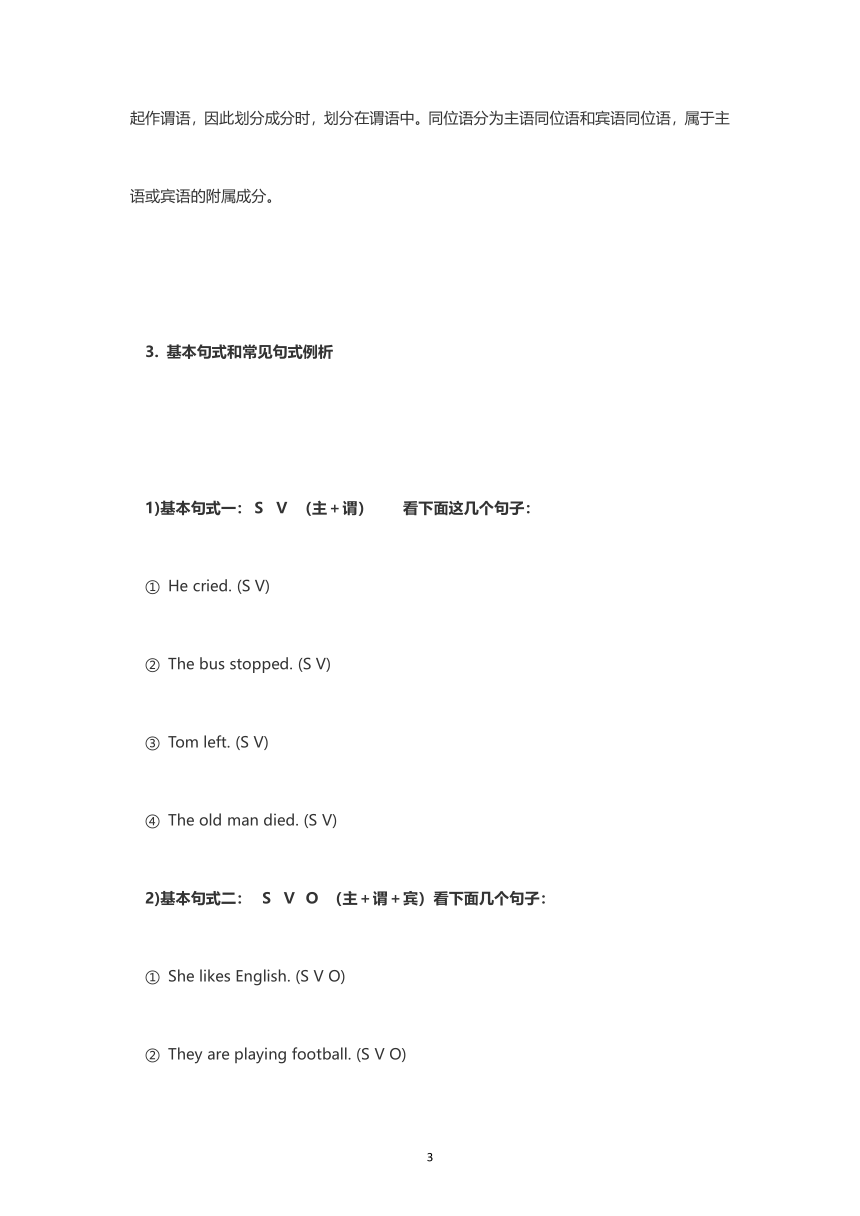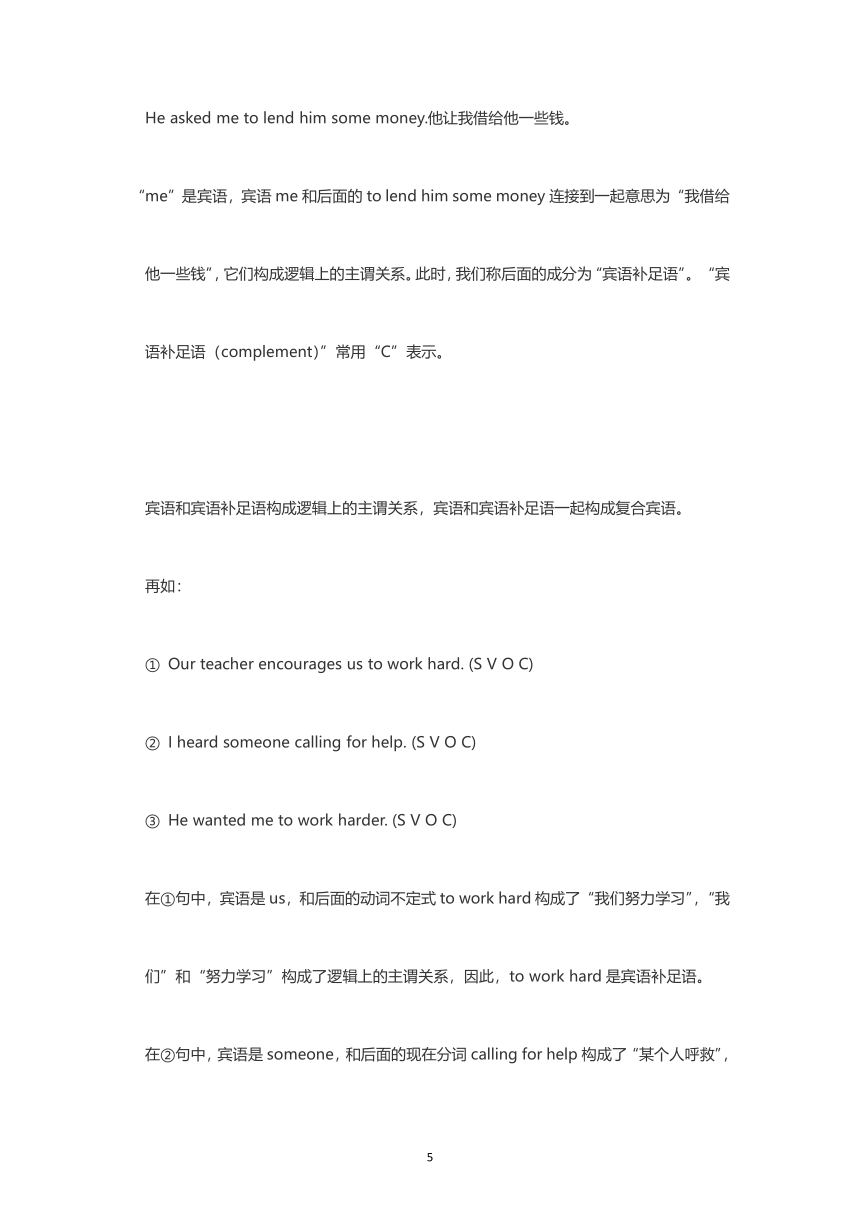2021-2022学年人教版(2019)必修一:Welcome unit 简单句结构和成分 学案(含答案)
文档属性
| 名称 | 2021-2022学年人教版(2019)必修一:Welcome unit 简单句结构和成分 学案(含答案) |  | |
| 格式 | docx | ||
| 文件大小 | 31.6KB | ||
| 资源类型 | 教案 | ||
| 版本资源 | 人教版(2019) | ||
| 科目 | 英语 | ||
| 更新时间 | 2021-09-04 19:11:46 | ||
图片预览





文档简介
2021-2022学年人教版(2019)必修一:Welcome
unit
简单句结构和成分
1.
简单句的五种基本结构
英语句子根据结构不同可以归纳成五种基本句型。英语中所有句子都可以看作是这五种句型及其扩展、组合、省略或倒装构成的。掌握这五种基本句型,是掌握各种英语句子结构的基础,也是学好其他语法知识的前提。
英语五种基本句式结构如下:用符号表示为:
①
S
V
(主+谓)
②
S
V
O
(主+谓+宾)
③
S
V
IO
DO
(主+谓+间宾+直宾)
④
S
V
O
C
(主+谓+宾+宾补)
⑤
S
V
P
(主+系+表)
S表示“主语(subject)”
V表示“动词(verb)”
O表示“宾语(object)”DO表示“直接宾语”
IO表示“间接宾语”
C表示“补语(complement)”P表示“表语(predicative)”A表示“状语”
另外还有三种常见句式
⑥SVA
(主+谓+状)
⑦SVOA
(主+谓+宾+状)
⑧
There
be
2.
句子成分
英语的句子成分主要有六种:主语、谓语、宾语、定语、状语和补语(可以简单记为:主谓宾,定状补)。除了这六种主要成分之外,还有“表语”和“同位语”。但表语和系动词一起作谓语,因此划分成分时,划分在谓语中。同位语分为主语同位语和宾语同位语,属于主语或宾语的附属成分。
基本句式和常见句式例析
1)基本句式一:S
V
(主+谓)
看下面这几个句子:
①
He
cried.
(S
V)
②
The
bus
stopped.
(S
V)
③
Tom
left.
(S
V)
④
The
old
man
died.
(S
V)
2)基本句式二:
S
V
O
(主+谓+宾)看下面几个句子:
①
She
likes
English.
(S
V
O)
②
They
are
playing
football.
(S
V
O)
③
We
like
swimming.
(S
V
O)
④
He
has
cleaned
the
windows.
(S
V
O)
3)基本句式三:SVIO
DO
(主+谓+间宾+直宾)看下面这个句子:
He
gave
me
a
book.
他给了我一本书。
“gave
me”,me是gave的宾语。“gave
a
book”,a
book也是gave的宾语。这样gave
就有两个宾语,一个表示人(me),是间接宾语;一个表示物(a
book),是直接宾语。这时我们说,gave后面跟双宾语。
再如:
①
He
passed
me
a
cup
of
tea.
(S
V
o
O)
②
She
bought
me
some
books.
(S
V
o
O)
③
He
sent
her
some
flowers.
(S
V
o
O)
4).
基本句式四:SVOC
(主+谓+宾+宾补)看下面这句话:
He
asked
me
to
lend
him
some
money.他让我借给他一些钱。
“me”是宾语,宾语me和后面的to
lend
him
some
money连接到一起意思为“我借给
他一些钱”,它们构成逻辑上的主谓关系。此时,我们称后面的成分为“宾语补足语”。
“宾语补足语(complement)”常用“C”表示。
宾语和宾语补足语构成逻辑上的主谓关系,宾语和宾语补足语一起构成复合宾语。
再如:
①
Our
teacher
encourages
us
to
work
hard.
(S
V
O
C)
②
I
heard
someone
calling
for
help.
(S
V
O
C)
③
He
wanted
me
to
work
harder.
(S
V
O
C)
在①句中,宾语是us,和后面的动词不定式to
work
hard构成了“我们努力学习”,“我们”和“努力学习”构成了逻辑上的主谓关系,因此,to
work
hard是宾语补足语。
在②句中,宾语是someone,和后面的现在分词calling
for
help构成了“某个人呼救”,“某个人”和“呼救”构成了逻辑上的主谓关系,因此,calling
for
help是宾语补足语。
练习1.
判断下列句中画线部分是否是宾语补足语(是的填T,不是的填F)
1.
I
want
him
to
come
at
once.
(
)
2.
He
made
the
boy
cry
again.
(
)
3.
The
teacher
found
him
cheating
in
the
exam.
(
)
4.
Don’t
leave
the
door
open
at
night.
(
)
5.
We
made
him
our
monitor.
(
)
6.
He
lent
me
some
money.
(
)
5)基本句型五:
S
V
P
(主+系+表)
“主系表”结构的主要特征是含有系动词。系动词主要是be
(am,
is,
are,
was,
were),意为“是”,含有系动词be的句子都是“主系表”结构,表语位于系动词的后面,系动词和表语一起构成句子的谓语。
①
He
is
in
the
classroom.
(S
V
P结构,介词短语作表语)
②
The
girl
is
pretty.
(S
V
P结构,形容词作表语)
③
My
brother
is
sixteen.
(S
V
P结构,数词作表语)
④
His
father
is
a
teacher.
(S
V
P结构,名词作表语)
注意:进行时和被动语态中的be是助动词,不是系动词。
①
He
is
writing.(be是助动词,构成现在进行时;本句是主谓结构)
②
The
classroom
is
cleaned
every
day.
(be是助动词,构成被动语态;本句是主谓结构)
另外,除系动词be外,还有一些也是系动词。系动词后就是表语,所以知道系动词,表语就找出来了,很容易。为方便记忆和总结,特把系动词做如下分类。
(
1.be
动词
(am
is
are
was
were
)
2.
感觉类:
feel
(
感觉
)touch(
摸起来
)l
ook
(看起来),
sound
(听起来),
smell
(闻起来),
taste
(尝起来)
变得类:
get
(变得),
turn
(变得)
become(
变得
)grow
(长得)
保持类
;keep
(
保持
)
remain
(
保持
)
stay
(
保持
)
其他类
;
prove
(证明)
seem
(似乎)
appear
(
好像
)come
true
(
实现
)
)
来看看更多的主系表结构吧,找到表语了吗?
①
The
trees
turn
green.
②
She
looks
happy.
③
It
seems
impossible.
④
The
moon
cakes
taste
delicious.
常见句型:SVA
(主+谓+状)
SVOA
(主+谓+宾+状)
状语常用来修饰动词、形容词、副词或整个句子,
说明动作或状态特征。
①
He
writes
carefully.(carefully修饰write,说明“写”的方式,是方式状语。SVA
(主+谓+状))
②
He
played
football
at
school.(at
school说明“踢足球”这一动作发生的地点,作地点状语。
SVOA
(主+谓+宾+状))
③
He
bought
a
dictionary
yesterday.
(yesterday说明“买字典”这一动作发生的时间,作时间状语。SVOA
(主+谓+宾+状))
④
The
trees
grew
extremely
slowly.(extremely修饰副词slowly,
说明“慢”的程度,作程度状语。SVA
(主+谓+状))
⑤
Unfortunately,
he
lost
all
of
his
money.(unfortunately指的是“他弄丢了所有的钱”这件事不幸,是评论性状语,修饰整个句子。)
7)常见句型
there
be句型
此句型是由“there
+
be
+
主语
+
状语”构成,用以表达“存在有”。there
be后名词或代词是句子的实义主语.
A.
be
要与其后的实义主语在人称和数上保持一致,如果be后实义主语是多个并列项,要按就近一致原则,与第一项保持一致
①
There
is
a
pencil
and
two
rulers
on
the
desk.(第一项是a
pencil,单数,所以用there
is)
②
There
are
two
rulers
and
a
pencil
on
the
desk.(第一项是two
rulers,复数,所以用there
are)
B.
可用
live,
stand,
come,
go,
lie,
remain,
exist,
arrive等词代替be动词此时还表示“存在有”,但表意要更具体一些。如:
①
There
lives
an
old
man
at
the
foot
of
the
mountain.
在山脚下住着一位老人。(不但“有”,而且“住”在那里。)
②
There
exists
no
air
on
the
moon.月球上没有空气。(exist是“存在”的意思。)
③
There
lies
a
book
on
the
desk.课桌上平放着一本书。
(不但“有”,而且说明书是“平放”在那里。)
④
There
stands
a
tree
on
the
hill.山上矗立着一棵树。
(不但说明“有”树,而且说明了树“矗立”在那里。)
练习:
①
______
a
certain
doubt
among
the
students
as
to
the
necessity
of
the
work.
A.
It
existed
B.
There
existedC.
They
had
D.
There
had
②
______
a
beautiful
palace
______
the
foot
of
the
hill.
A.
There
stand;
at
B.
There
stands;
underC.
Stands
there;
under
D.
There
stands;
at
4.补充:定语
定语用来修饰名词或代词,常译作“……的”。单个形容词作定语常放在被修饰词之前,短语作定语常放在被修饰词之后。
①
She
is
a
beautiful
girl.
她是个漂亮的女孩。
②
It
is
an
interesting
story.
这是个有趣的故事。
③
The
dictionary
on
the
desk
is
mine.
桌子上的那本字典是我的。
④
The
girl
crying
over
there
is
Tom’s
sister.
在那边哭的那个女孩是汤姆的妹妹。
5.能力提升
练习1.
分析下列句子成分,并在后面括号内标明属于五种基本句型中的哪一种
1.
Dark
clouds
hung
overhead.
(
)
2.
Gradually
a
smile
appeared
on
her
face.
(
)
3.
He
is
smiling
all
over
his
face.
(
)
4.
I
did
well
in
English.
(
)
5.
He
talked
loudly
in
the
classroom
yesterday.
(
)
6.
The
bus
stopped
suddenly.
(
)
7.
He
is
leaving
tomorrow.
(
)
8.
Something
terrible
happened
yesterday.
(
)
练习2.
分析下列句子成分,并在后面括号内标明属于五种基本句型中的哪一种
1.
People
all
over
the
world
speak
English.
(
)
2.
Jim
cannot
dress
himself.
(
)
3.
All
of
us
believe
that
Jack
is
an
honest
boy.
(
)
4.
He
did
not
know
what
to
say.
(
)
5.
He
just
wanted
to
stay
at
home.
(
)
6.
He
practices
speaking
English
every
day.
(
)
7.
They
will
stop
working
at
eleven.
(
)
8.
He
is
having
supper
at
home
now.
(
)
练习3.
分析下列句子成分,并在后面括号内标明属于五种基本句型中的哪一种
1.
She
ordered
herself
a
new
dress.
(
)
2.
She
cooked
her
husband
a
delicious
meal.
(
)
3.
He
brought
you
a
dictionary.
(
)
4.
He
denies
her
nothing.
(
)
5.
I
showed
him
my
pictures.
(
)
6.
I
gave
my
car
a
wash.
(
)
7.
I
told
him
that
the
bus
was
late.
(
)
8.
He
showed
me
how
to
run
the
machine.
(
)
练习4.
分析下列句子成分,并在后面括号内标明属于五种基本句型中的哪一种
1.
I
asked
him
to
come
on
time.
(
)
2.
We
saw
her
entering
the
room.
(
)
3.
He
kept
his
hands
behind
his
back.
(
)
4.
He
cut
the
box
open.
(
)
5.
Let
the
fresh
air
in.
(
)
6.
The
manager
wanted
the
work
done
on
time.
(
)
7.
His
father
named
him
Dongming.
(
)
8.
They
painted
their
boat
white.
(
)
能力提升答案:
练习1.
1.
Dark
clouds
hung
overhead.
(SV)
2.
Gradually
a
smile
appeared
on
her
face.
(SV)
3.
He
is
smiling
all
over
his
face.
(SV)
4.
I
did
well
in
English.
(SV)
5.
He
talked
loudly
in
the
classroom
yesterday.
(SV)
6.
The
bus
stopped
suddenly.
(SV)
7.
He
is
leaving
tomorrow.
(SV)
8.
Something
terrible
happened
yesterday.
(SV)
练习2.
1.
People
all
over
the
world
speak
English.
(SVO)
2.
Jim
cannot
dress
himself.
(SVO)
3.
All
of
us
believe
that
Jack
is
an
honest
boy.
(SVO)
4.
He
did
not
know
what
to
say.
(SVO)
5.
He
just
wanted
to
stay
at
home.
(SVO)
6.
He
practices
speaking
English
every
day.
(SVO)
7.
They
will
stop
working
at
eleven.
(SVO)
8.
He
is
having
supper
at
home
now.
(SVO)
练习3.
1.
She
ordered
herself
a
new
dress.
(SvoO)
2.
She
cooked
her
husband
a
delicious
meal.
(SvoO)
3.
He
brought
you
a
dictionary.
(SvoO)
4.
He
denies
her
nothing.
(SvoO)
5.
I
showed
him
my
pictures.
(SvoO)
6.
I
gave
my
car
a
wash.
(SvoO)
7.
I
told
him
that
the
bus
was
late.
(SvoO)
8.
He
showed
me
how
to
run
the
machine.
(SvoO)
练习4.
1.
I
asked
him
to
come
on
time.
(
SVOC
)
2.
We
saw
her
entering
the
room.
(
SVOC
)
3.
He
kept
his
hands
behind
his
back.
(
SVOC
)
4.
He
cut
the
box
open.
(
SVOC
)
5.
Let
the
fresh
air
in.
(
SVOC
)
6.
The
manager
wanted
the
work
done
on
time.
(
SVOC
)
7.
His
father
named
him
Dongming.
(
SVOC
)
8.
They
painted
their
boat
white.
(
SVOC
)
(
1
)
unit
简单句结构和成分
1.
简单句的五种基本结构
英语句子根据结构不同可以归纳成五种基本句型。英语中所有句子都可以看作是这五种句型及其扩展、组合、省略或倒装构成的。掌握这五种基本句型,是掌握各种英语句子结构的基础,也是学好其他语法知识的前提。
英语五种基本句式结构如下:用符号表示为:
①
S
V
(主+谓)
②
S
V
O
(主+谓+宾)
③
S
V
IO
DO
(主+谓+间宾+直宾)
④
S
V
O
C
(主+谓+宾+宾补)
⑤
S
V
P
(主+系+表)
S表示“主语(subject)”
V表示“动词(verb)”
O表示“宾语(object)”DO表示“直接宾语”
IO表示“间接宾语”
C表示“补语(complement)”P表示“表语(predicative)”A表示“状语”
另外还有三种常见句式
⑥SVA
(主+谓+状)
⑦SVOA
(主+谓+宾+状)
⑧
There
be
2.
句子成分
英语的句子成分主要有六种:主语、谓语、宾语、定语、状语和补语(可以简单记为:主谓宾,定状补)。除了这六种主要成分之外,还有“表语”和“同位语”。但表语和系动词一起作谓语,因此划分成分时,划分在谓语中。同位语分为主语同位语和宾语同位语,属于主语或宾语的附属成分。
基本句式和常见句式例析
1)基本句式一:S
V
(主+谓)
看下面这几个句子:
①
He
cried.
(S
V)
②
The
bus
stopped.
(S
V)
③
Tom
left.
(S
V)
④
The
old
man
died.
(S
V)
2)基本句式二:
S
V
O
(主+谓+宾)看下面几个句子:
①
She
likes
English.
(S
V
O)
②
They
are
playing
football.
(S
V
O)
③
We
like
swimming.
(S
V
O)
④
He
has
cleaned
the
windows.
(S
V
O)
3)基本句式三:SVIO
DO
(主+谓+间宾+直宾)看下面这个句子:
He
gave
me
a
book.
他给了我一本书。
“gave
me”,me是gave的宾语。“gave
a
book”,a
book也是gave的宾语。这样gave
就有两个宾语,一个表示人(me),是间接宾语;一个表示物(a
book),是直接宾语。这时我们说,gave后面跟双宾语。
再如:
①
He
passed
me
a
cup
of
tea.
(S
V
o
O)
②
She
bought
me
some
books.
(S
V
o
O)
③
He
sent
her
some
flowers.
(S
V
o
O)
4).
基本句式四:SVOC
(主+谓+宾+宾补)看下面这句话:
He
asked
me
to
lend
him
some
money.他让我借给他一些钱。
“me”是宾语,宾语me和后面的to
lend
him
some
money连接到一起意思为“我借给
他一些钱”,它们构成逻辑上的主谓关系。此时,我们称后面的成分为“宾语补足语”。
“宾语补足语(complement)”常用“C”表示。
宾语和宾语补足语构成逻辑上的主谓关系,宾语和宾语补足语一起构成复合宾语。
再如:
①
Our
teacher
encourages
us
to
work
hard.
(S
V
O
C)
②
I
heard
someone
calling
for
help.
(S
V
O
C)
③
He
wanted
me
to
work
harder.
(S
V
O
C)
在①句中,宾语是us,和后面的动词不定式to
work
hard构成了“我们努力学习”,“我们”和“努力学习”构成了逻辑上的主谓关系,因此,to
work
hard是宾语补足语。
在②句中,宾语是someone,和后面的现在分词calling
for
help构成了“某个人呼救”,“某个人”和“呼救”构成了逻辑上的主谓关系,因此,calling
for
help是宾语补足语。
练习1.
判断下列句中画线部分是否是宾语补足语(是的填T,不是的填F)
1.
I
want
him
to
come
at
once.
(
)
2.
He
made
the
boy
cry
again.
(
)
3.
The
teacher
found
him
cheating
in
the
exam.
(
)
4.
Don’t
leave
the
door
open
at
night.
(
)
5.
We
made
him
our
monitor.
(
)
6.
He
lent
me
some
money.
(
)
5)基本句型五:
S
V
P
(主+系+表)
“主系表”结构的主要特征是含有系动词。系动词主要是be
(am,
is,
are,
was,
were),意为“是”,含有系动词be的句子都是“主系表”结构,表语位于系动词的后面,系动词和表语一起构成句子的谓语。
①
He
is
in
the
classroom.
(S
V
P结构,介词短语作表语)
②
The
girl
is
pretty.
(S
V
P结构,形容词作表语)
③
My
brother
is
sixteen.
(S
V
P结构,数词作表语)
④
His
father
is
a
teacher.
(S
V
P结构,名词作表语)
注意:进行时和被动语态中的be是助动词,不是系动词。
①
He
is
writing.(be是助动词,构成现在进行时;本句是主谓结构)
②
The
classroom
is
cleaned
every
day.
(be是助动词,构成被动语态;本句是主谓结构)
另外,除系动词be外,还有一些也是系动词。系动词后就是表语,所以知道系动词,表语就找出来了,很容易。为方便记忆和总结,特把系动词做如下分类。
(
1.be
动词
(am
is
are
was
were
)
2.
感觉类:
feel
(
感觉
)touch(
摸起来
)l
ook
(看起来),
sound
(听起来),
smell
(闻起来),
taste
(尝起来)
变得类:
get
(变得),
turn
(变得)
become(
变得
)grow
(长得)
保持类
;keep
(
保持
)
remain
(
保持
)
stay
(
保持
)
其他类
;
prove
(证明)
seem
(似乎)
appear
(
好像
)come
true
(
实现
)
)
来看看更多的主系表结构吧,找到表语了吗?
①
The
trees
turn
green.
②
She
looks
happy.
③
It
seems
impossible.
④
The
moon
cakes
taste
delicious.
常见句型:SVA
(主+谓+状)
SVOA
(主+谓+宾+状)
状语常用来修饰动词、形容词、副词或整个句子,
说明动作或状态特征。
①
He
writes
carefully.(carefully修饰write,说明“写”的方式,是方式状语。SVA
(主+谓+状))
②
He
played
football
at
school.(at
school说明“踢足球”这一动作发生的地点,作地点状语。
SVOA
(主+谓+宾+状))
③
He
bought
a
dictionary
yesterday.
(yesterday说明“买字典”这一动作发生的时间,作时间状语。SVOA
(主+谓+宾+状))
④
The
trees
grew
extremely
slowly.(extremely修饰副词slowly,
说明“慢”的程度,作程度状语。SVA
(主+谓+状))
⑤
Unfortunately,
he
lost
all
of
his
money.(unfortunately指的是“他弄丢了所有的钱”这件事不幸,是评论性状语,修饰整个句子。)
7)常见句型
there
be句型
此句型是由“there
+
be
+
主语
+
状语”构成,用以表达“存在有”。there
be后名词或代词是句子的实义主语.
A.
be
要与其后的实义主语在人称和数上保持一致,如果be后实义主语是多个并列项,要按就近一致原则,与第一项保持一致
①
There
is
a
pencil
and
two
rulers
on
the
desk.(第一项是a
pencil,单数,所以用there
is)
②
There
are
two
rulers
and
a
pencil
on
the
desk.(第一项是two
rulers,复数,所以用there
are)
B.
可用
live,
stand,
come,
go,
lie,
remain,
exist,
arrive等词代替be动词此时还表示“存在有”,但表意要更具体一些。如:
①
There
lives
an
old
man
at
the
foot
of
the
mountain.
在山脚下住着一位老人。(不但“有”,而且“住”在那里。)
②
There
exists
no
air
on
the
moon.月球上没有空气。(exist是“存在”的意思。)
③
There
lies
a
book
on
the
desk.课桌上平放着一本书。
(不但“有”,而且说明书是“平放”在那里。)
④
There
stands
a
tree
on
the
hill.山上矗立着一棵树。
(不但说明“有”树,而且说明了树“矗立”在那里。)
练习:
①
______
a
certain
doubt
among
the
students
as
to
the
necessity
of
the
work.
A.
It
existed
B.
There
existedC.
They
had
D.
There
had
②
______
a
beautiful
palace
______
the
foot
of
the
hill.
A.
There
stand;
at
B.
There
stands;
underC.
Stands
there;
under
D.
There
stands;
at
4.补充:定语
定语用来修饰名词或代词,常译作“……的”。单个形容词作定语常放在被修饰词之前,短语作定语常放在被修饰词之后。
①
She
is
a
beautiful
girl.
她是个漂亮的女孩。
②
It
is
an
interesting
story.
这是个有趣的故事。
③
The
dictionary
on
the
desk
is
mine.
桌子上的那本字典是我的。
④
The
girl
crying
over
there
is
Tom’s
sister.
在那边哭的那个女孩是汤姆的妹妹。
5.能力提升
练习1.
分析下列句子成分,并在后面括号内标明属于五种基本句型中的哪一种
1.
Dark
clouds
hung
overhead.
(
)
2.
Gradually
a
smile
appeared
on
her
face.
(
)
3.
He
is
smiling
all
over
his
face.
(
)
4.
I
did
well
in
English.
(
)
5.
He
talked
loudly
in
the
classroom
yesterday.
(
)
6.
The
bus
stopped
suddenly.
(
)
7.
He
is
leaving
tomorrow.
(
)
8.
Something
terrible
happened
yesterday.
(
)
练习2.
分析下列句子成分,并在后面括号内标明属于五种基本句型中的哪一种
1.
People
all
over
the
world
speak
English.
(
)
2.
Jim
cannot
dress
himself.
(
)
3.
All
of
us
believe
that
Jack
is
an
honest
boy.
(
)
4.
He
did
not
know
what
to
say.
(
)
5.
He
just
wanted
to
stay
at
home.
(
)
6.
He
practices
speaking
English
every
day.
(
)
7.
They
will
stop
working
at
eleven.
(
)
8.
He
is
having
supper
at
home
now.
(
)
练习3.
分析下列句子成分,并在后面括号内标明属于五种基本句型中的哪一种
1.
She
ordered
herself
a
new
dress.
(
)
2.
She
cooked
her
husband
a
delicious
meal.
(
)
3.
He
brought
you
a
dictionary.
(
)
4.
He
denies
her
nothing.
(
)
5.
I
showed
him
my
pictures.
(
)
6.
I
gave
my
car
a
wash.
(
)
7.
I
told
him
that
the
bus
was
late.
(
)
8.
He
showed
me
how
to
run
the
machine.
(
)
练习4.
分析下列句子成分,并在后面括号内标明属于五种基本句型中的哪一种
1.
I
asked
him
to
come
on
time.
(
)
2.
We
saw
her
entering
the
room.
(
)
3.
He
kept
his
hands
behind
his
back.
(
)
4.
He
cut
the
box
open.
(
)
5.
Let
the
fresh
air
in.
(
)
6.
The
manager
wanted
the
work
done
on
time.
(
)
7.
His
father
named
him
Dongming.
(
)
8.
They
painted
their
boat
white.
(
)
能力提升答案:
练习1.
1.
Dark
clouds
hung
overhead.
(SV)
2.
Gradually
a
smile
appeared
on
her
face.
(SV)
3.
He
is
smiling
all
over
his
face.
(SV)
4.
I
did
well
in
English.
(SV)
5.
He
talked
loudly
in
the
classroom
yesterday.
(SV)
6.
The
bus
stopped
suddenly.
(SV)
7.
He
is
leaving
tomorrow.
(SV)
8.
Something
terrible
happened
yesterday.
(SV)
练习2.
1.
People
all
over
the
world
speak
English.
(SVO)
2.
Jim
cannot
dress
himself.
(SVO)
3.
All
of
us
believe
that
Jack
is
an
honest
boy.
(SVO)
4.
He
did
not
know
what
to
say.
(SVO)
5.
He
just
wanted
to
stay
at
home.
(SVO)
6.
He
practices
speaking
English
every
day.
(SVO)
7.
They
will
stop
working
at
eleven.
(SVO)
8.
He
is
having
supper
at
home
now.
(SVO)
练习3.
1.
She
ordered
herself
a
new
dress.
(SvoO)
2.
She
cooked
her
husband
a
delicious
meal.
(SvoO)
3.
He
brought
you
a
dictionary.
(SvoO)
4.
He
denies
her
nothing.
(SvoO)
5.
I
showed
him
my
pictures.
(SvoO)
6.
I
gave
my
car
a
wash.
(SvoO)
7.
I
told
him
that
the
bus
was
late.
(SvoO)
8.
He
showed
me
how
to
run
the
machine.
(SvoO)
练习4.
1.
I
asked
him
to
come
on
time.
(
SVOC
)
2.
We
saw
her
entering
the
room.
(
SVOC
)
3.
He
kept
his
hands
behind
his
back.
(
SVOC
)
4.
He
cut
the
box
open.
(
SVOC
)
5.
Let
the
fresh
air
in.
(
SVOC
)
6.
The
manager
wanted
the
work
done
on
time.
(
SVOC
)
7.
His
father
named
him
Dongming.
(
SVOC
)
8.
They
painted
their
boat
white.
(
SVOC
)
(
1
)
